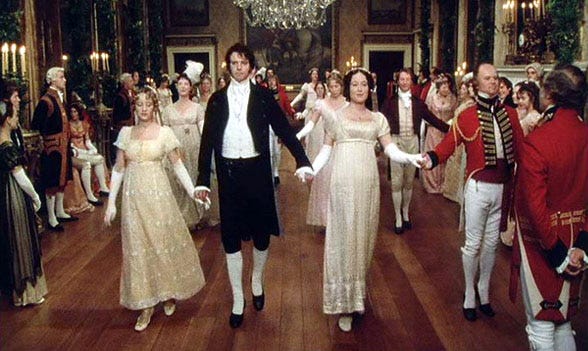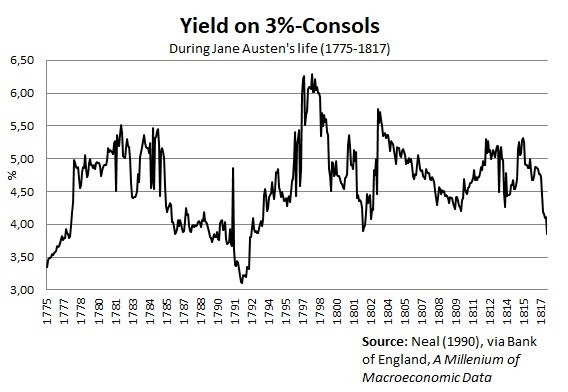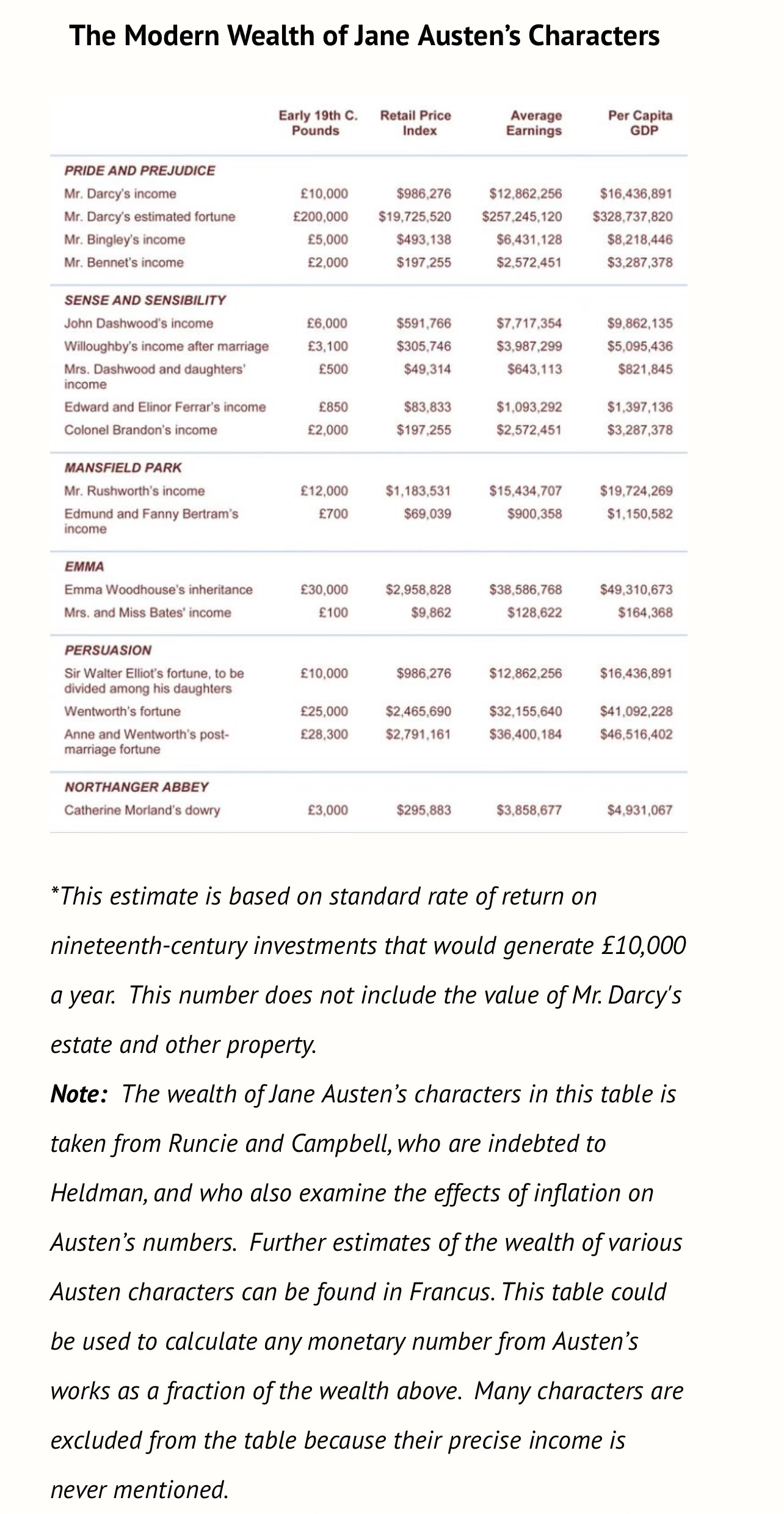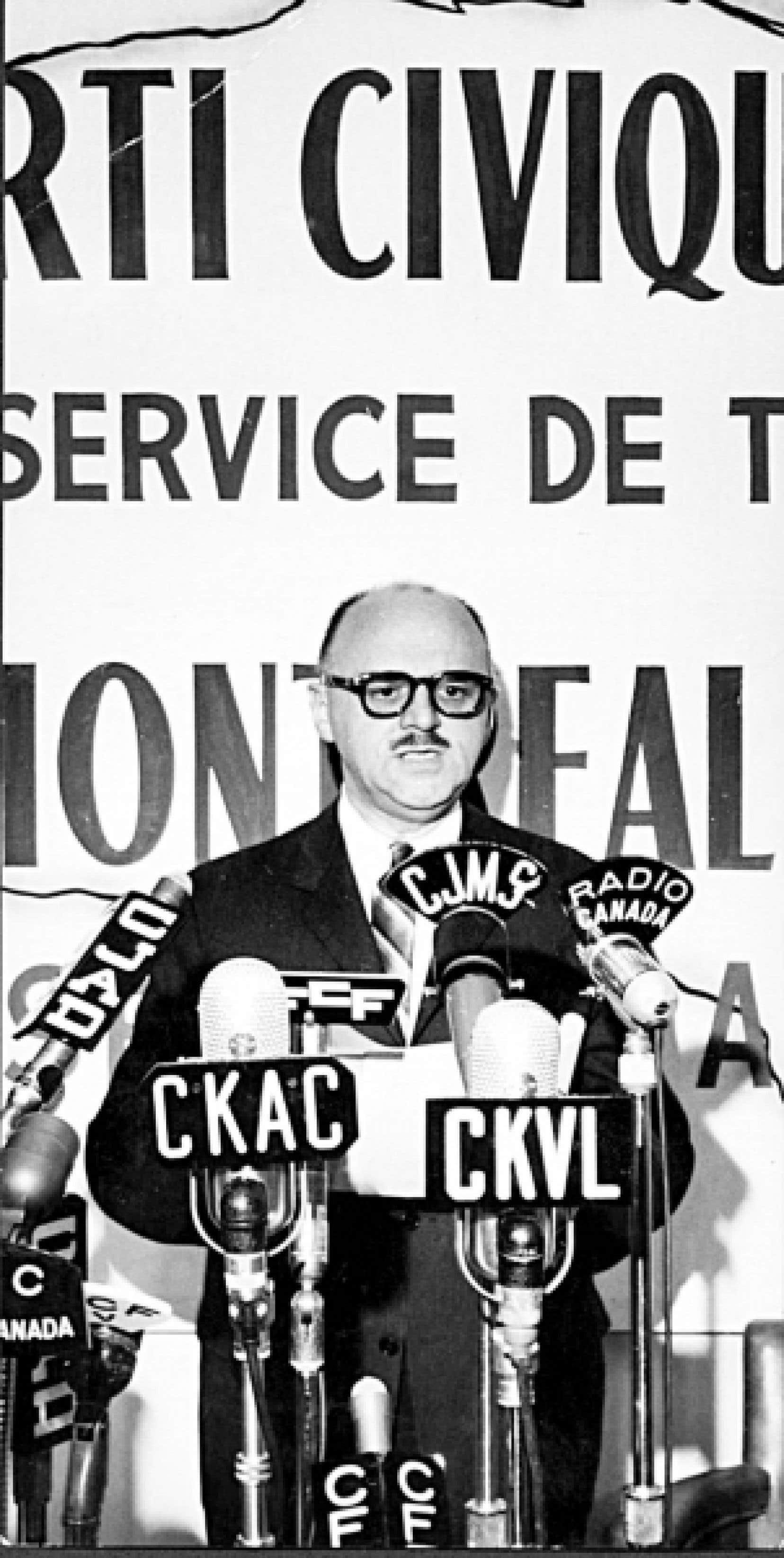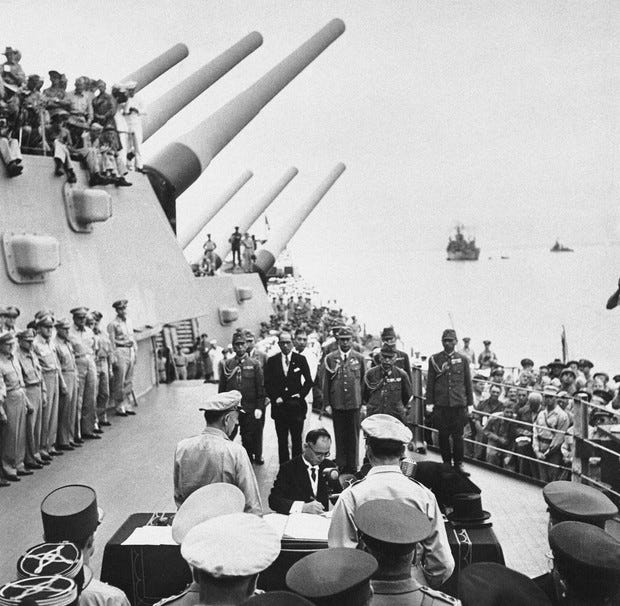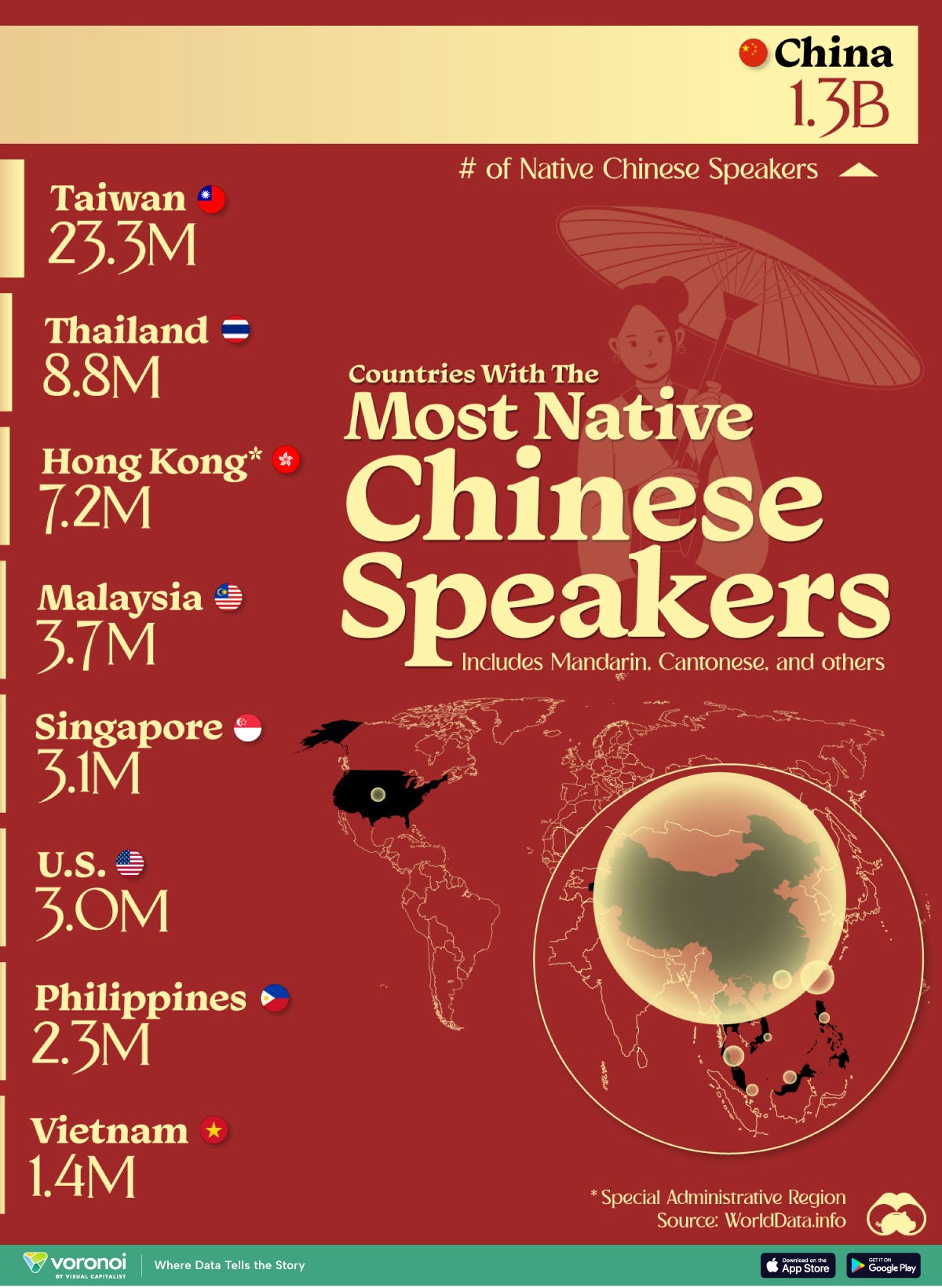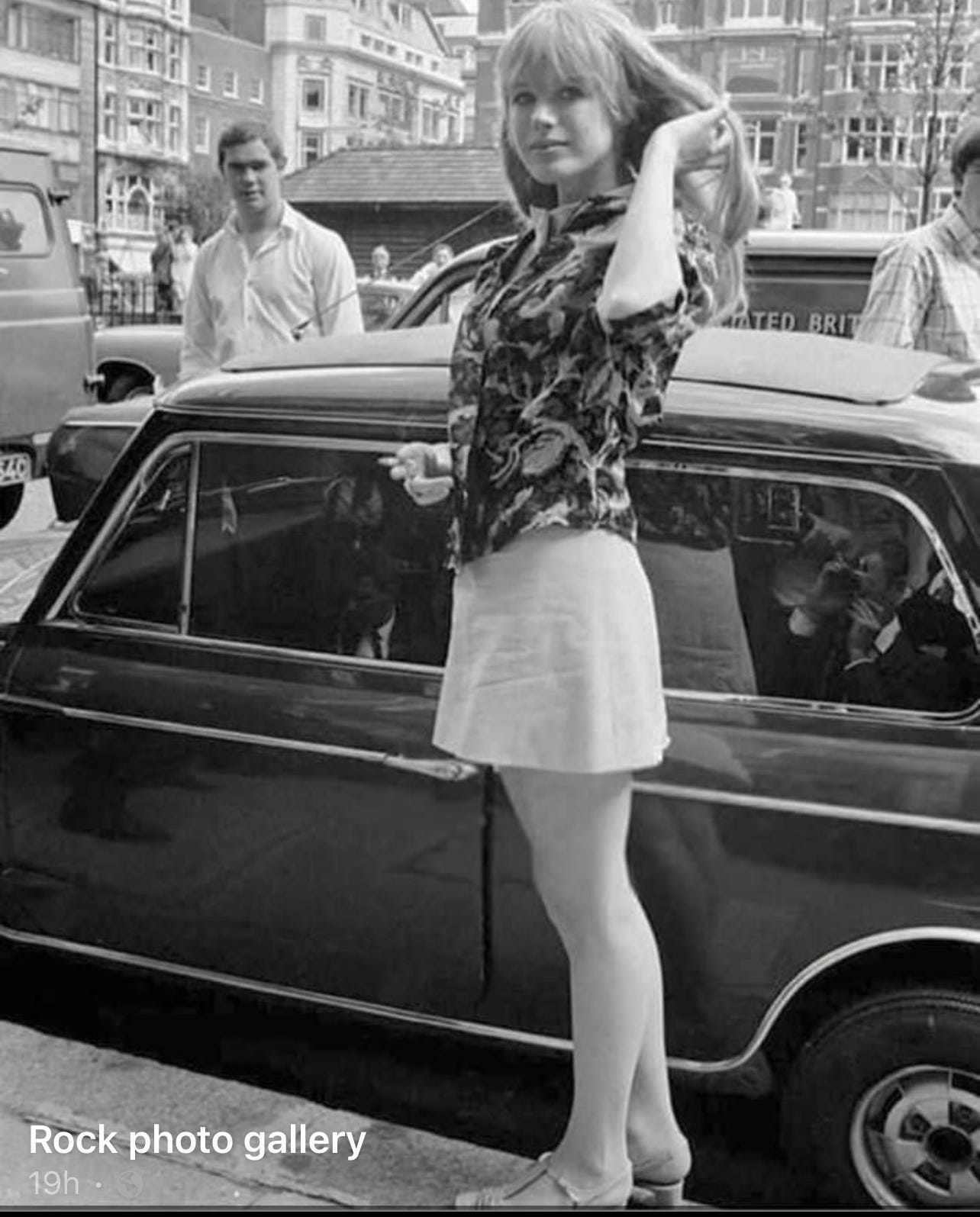Unemployment Rising, Stocks Falling
In both Canada and the United States. Not by that much, but enough to panic stock markets which sold off big time on Friday.
Traders figured the US Federal Reserve won’t keep cutting rates. Economist Hubert Marleau disagrees: “Meanwhile, the S&P 500 closed at 5408 on Friday, registering a loss of 200 points or 3.5% for the week. Perhaps a good entry point because the Fed will soon be on a rescue mission to shore up the economy.”
Just How Rich was Mr. Darcy?
Pride and Prejudice is perhaps the most popular of Jane Austen’s four novels. Its opening line is one of the best known in English literature and often quoted: It is a truth universally acknowledged, that a single man in possession of a good fortune, must be in want of a wife.
Dancing at the Netherfield Ball. Colin Firth as Mr. Darcy, a single man of good fortune, and on his left Jennifer Ehle as Elizabeth Bennet. It is here that Mr. Darcy hears Elizabeth’s mother talk about him having ten thousand a year. Mrs. Bennet makes the mistake of equating income with wealth. We learn later on that Mr. Darcy also has a vast estate, but that £10,000 a year could come from Consols, the equivalent of government bonds. Consols paid 3% in perpetuity. They fluctuated in price, like modern bonds, so income could be higher than 3%, depnding where in the cycle you bought them.
But how much was £10,000 a year in 1813, the year Jane Austen wrote Pride and Prejudice? A simple comparison is a labourer made £12 a year, a bailiff £20.
There are many answers about Mr. Darcy on the Internet. There is no doubt that Mr. Darcy’s income put him in the top one per cent or better. This is the best chart I came across from the Jane Austen Society of North America. They convert everything to US dollars and correct it to 2015. Forget the last two columns unless you read the whole article. Many other sites give Mr. Darcy an income in today’s money of £12-million a year. But that could be unrealistic because as this stie points out the British economy was a lot different back then. For example, Mr. Darcy’s income from his estate was set to drop over the 19th century. It was in many ways still a barter economy at the start of the Industrial Revolution.
Click here to heard the report this chart comes from.
My Favourite Version of Pride and Prejudice.
Is the BBC series with Colin Firth. After watching it I read the book which is equally enjoyable. I think I have watched the series at least three times.
Battleships
When I was a boy in Montreal in the 1950s I lived near a hobby store and I spent a lot of time in there dreaming of models of planes and ships I might buy with the money I made from my paper route. I sometimes delivered the Montreal Gazette though for many years my brother and I delivered the French-language Le Devoir, which was much more lucrative. I rememeber one morning when the paper urged its readers to vote for Jean Drapeau as mayor. We were mebarrassed to deliver the paper to the existing mayor, Sarto Fournier, who was on our route, and who lost the election.
Back to where I spent my paper money, Most of the models were American war planes and ships. I remember building an F-102 fighter but my most ambitious project was the USS Missouri, the ship on which the Japanese surrender was signed in Tokyo Harbour on September 2, 1945.
The model came in a box with all the plastic bits you had to glue together. You bought the glue separately and it took a long time to put together.
Because of building that model I knew quite a bit about the USS Missouri. It and its sister ships, New Jersey, Wisconsin and Iowa, had nine 16-inch guns, six of which you can see in the picture above; they were fast and almost invulnerable to shells from smaller ships. About 25 years ago, while staying with a friend near Vero Beach, Florida, I met a man who served on the Missouri.
All the big American battleships are retired and are pristine museum pieces. But there are a lot of romatics who think they could be revived. Popular Mechanics ran a dreamy article recently that specuated the big battleships like the Missouri and the New Jersey could be made ready for war in 60 days.
Rubbish, says a website called The National Interest. For starters there are no spare parts and no one in the United States makes the big 16 inch shells. But most important, battleships send a shell maybe 23 miles. They are great floating artillery pieces. And they are huge, vulnerable targets for anti-ship missiles. The battleship is never coming back, no matter what the fanboys at Popular Mechanics think.
Where People Speak Chinese
London Swinging 60s Goddess
Marianne Faithful and a Mini. Singer, songwriter, Mick Jagger’s girlfriend and though the ideal of swinging 60s London she was in fact the daughter of an Austrian aristocrat. Her best known song was As Tears Go By, wrrtten by Jagger and Keith Richards, though other songs she wrote are said to be better. She dropped out in the late 60s and made a musical comeback in the late 1970s. She is 77 and still alive.
As Tears Go By: click to listen
Essay of The Week
Continuing with stories of great reporters of the past, here is an obit of a woman who wrote her way out of the women’s pages and onto the front page. I knew her, but not well. Her friends called her Bunny.
Angela Burke, was the first woman to sit in the city room of the Toronto Star and report on hard news, from murders to elections and feature profiles of foreign countries. It was a time when women were relegated to the sections of the paper that dealt with recipes, weddings and fashion. She was hired in 1951 and was soon travelling the world for the Toronto Star, which in those days was in a vicious circulation battle with the Toronto Telegram, and to a lesser extent the Globe and Mail.
“Burke was soon not simply reporting the news - she was news,” wrote Patricia Orwen in a May 24, 1992, article in the Toronto Star, titled Women of The Star.
She spent six weeks in the Soviet Union in 1955 sending features and hard news stories home, including an interview with Soviet leader Nikita Khrushchev. She also sailed on the ship carrying Grace Kelly of Philadelphia on her way to her wedding to become Princess Grace of Monaco.
Like any good reporter Ms Burke had a cynical edge. She said of the marriage ceremony: “It was more like a premiere than a church wedding.”
During one of her trips to Europe, she interviewed Hitler’s chauffer and valet who had just been released after a decade in prison. She also interviewed some of the great celebrities of the mid 20thcentury: she said of a Madrid encounter with Frank Sinatra `he was electric’; and of Sophia Loren, who she said was “more the college sophomore than the sexy siren.’ And she did became the news: One headline in 1955 screamed, "Angela asked to Dine with Greek Royalty."
The United Press described her as the "glamorous blonde Angela Burke of the Toronto Star".
“The dramatic thing was they sent a woman, It was an exception back then,” said John Honderich, current Chair of the Torstar Corporation, and a former editor and publisher of the paper. He added that today women editors dominate the paper.
"I had great opportunities," Ms Burke told an interviewer many years after her retirement. "I never felt being a woman held me back . . . this is a profession that women can do well in and by the time I left, a lot more women were coming in."
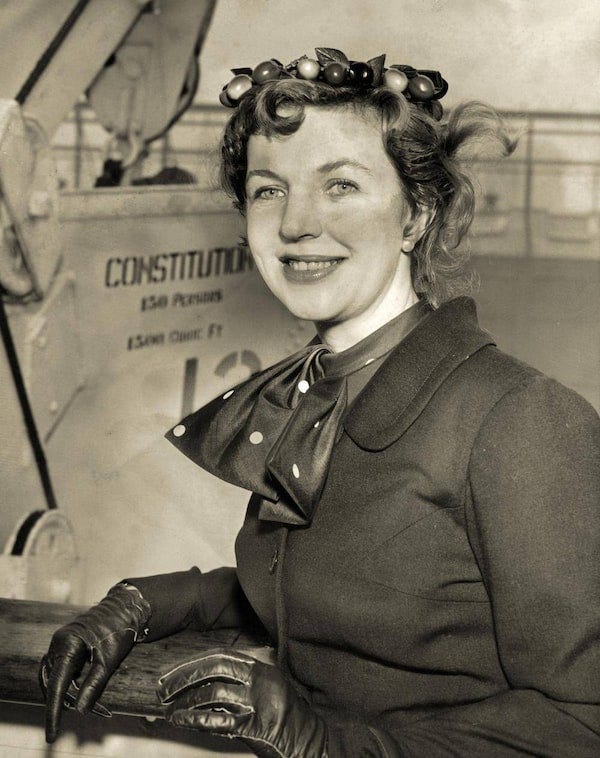
All her life Angela Burke was known by her family and friends as Bunny, though the nickname never appeared in a byline. She was born on October 3, 1920, in Buffalo, New York. Her parents were worried about what could be a difficult birth so they travelled to Buffalo, then the 11th largest city in the United States, because of the excellent hospitals there. That left baby Angela an American citizen, as well as a Canadian, and she had to renounce her US citizenship when she worked for the British embassy in Washington during the Second World War.
Angela’s father Frank was a pharmacist and entrepreneur, who prospered and owned more than one drug store. Her mother, Ruth Gagnon, was a Franco-Ontarian, who made sure her daughter learned French, something that helped in her journalistic career.
The family spent winters in Florida, travelling there by train. Her father owned an ocean front property in Fort Lauderdale and a pharmacy there as well.
At the age of 5 she was sent to a series of convents: Loretto Abbey in Toronto and then Couvent de Ste Marie, a French language boarding school in Haileybury in northern Ontario. It was a dour place with strict rules, and Angela, along with her older sister Margaret rose at 5:30 am for prayers, mass and then breakfast. Angela and her friends though were rebellious.
“It was in the fall of our second year at the convent that we became aware of the Cathedral’s six altar boys,” she wrote in her memoir. “After several weeks of eye contact, six of us, through the intercession of day boarders, acquired beaux and love notes began to be relayed through the network of day students…. snub nosed Roger McCurdy, the bishop’s pageboy was my beau.”
Eventually they were caught and young Angela was in tears as the nuns mocked her as a person with “a ruined character” and she and the others were paraded in front of the Bishop. She recalled the incident:
“Before we leave this assembly, the Directress said, I want his excellency to see what boy-crazy girls look like.” Angela was 14. Ten-year-old altar boys who wouldn’t attract any romantic interest replaced the guilty males.
The next year the two girls went to Loretto Abbey in Toronto and her sister Margaret soon insisted on being sent to `Protestant’ Branksome Hall, a private girls’ school.
After graduating in 1938, Angela and her sister went to France for a year. They were accompanied on the liner the Queen Mary by a chaperone, though someone who was nowhere near as strict as the nuns. Once in Paris they were in a convent, though a much more relaxed place than the one in Hailleybury. She and her sister travelled to many place in Europe, again with a chaperone. It left Angela with a lifelong love of travel and a longing for adventure. All her life she told her friends the tensions of Europe in the late 1930s left her with a thirst for following current events.
When she returned from Paris she went to McGill University in Montreal. After her years in convents she longed for adventure and decided to see the world. At least one man proposed marriage while she was at McGill, and she did marry him, but in 1972 not 1942.
“I fell in love with journalism in 1943 while reading the reportage of the Isaiah Berlin, a don at Britain’s Oxford University on loan to Washington’s British Embassy,” wrote Ms Burke in her unpublished memoir. She was a file clerk in the press office of the British Information Service.
“They portrayed a rather Machiavellian British viewpoint of a country that had governed much of the world for the past 200 years, contrasting it with the fledging American emergence in the atmosphere of realpolitik…”
She led an exciting life in wartime Washington, mixing with the military and secret service elite at events such as dinners on the presidential yacht Sequoia. When the war ended she came back to earth and back to Canada to start her newspaper career as Women’s Editor of the Daily Press in Timmins, a paper owned by Roy Thomson. After a short stint in what called the `dreary women’s pages’ she left for New York City in 1946 to work and look in on journalism classes at Columbia.
Her first newspaper job was with Kemsley newspapers, which owned the Times of London among other titles. She recalled that when she started the foreign editor of the chain was Ian Fleming, the writer who created James Bond. She interviewed British celebrities such as Bea Lillie visiting New York or Americans like Dinah Shore on their way to London.
Covering the setup of the Democratic convention of July, 1948, was her `most memorable’ assignment at the news bureau. The convention was the first to be televised.
“So disdainful were press and radio personnel of the idea that television was invading their territory that even Edward R. Murrow and Eric Sevareid (star war correspondent of CBS radio) had to be cajoled by their bosses into taking part,” she wrote.
That year her father died and she returned to Canada. A year later she applied or a job at the Toronto Star, but she wanted to work in news and wrote the publisher, Harry Hindmarsh a rather brash letter.
“Females were hired only in the women’s section to cover weddings and social events,” she said. “The city editor, who was shown my letter by his superior, said he was stunned at my indiscretions. A few days later he called me to send me on a assignment to an outpost hospital in rural Manitoba with a photographer.”
After she filed that story she was hired on as the first woman reporter to sit in the city room. She flew all over Canada and the United States, tracking down an Indian grandmother who vowed to shoot any male interfering with her trap line to stories in Newfoundland and its early days in Confederation.
“Reporting at the Star… was often a circus and much of the time fun.”
Many of her stories dealt with women, but she was not on the woman’s page. She covered a `rockettes line of lady bullfighters’ in Mexico and the travails of the Dionne quintuplets. She also interviewed President Dwight Eisenhower’s wife Mamie, shortly after his first election in 1952. But she said her most unforgettable interview was with Helen Keller, who was 74 at the time.
Ms Burke covered election campaigns and royal tours. After following the Liberal leader, Lester Pearson, in the election of 1958, which the Conservative Prime Minister John Diefenbaker won in a landslide, Mr. Pearson sent a note to Ms Burke, which would be unheard of today.
“Dear Angela, Mrs. Pearson and I want to say how much we enjoyed having with us during the convention and also during the recent campaign.”
She was always a Liberal supporter, and admitted it openly, but was lukewarm about the royal family. She wrote a long opinion piece about it in Maclean’s Magazine of May 23, 1959, admitting that as a reporter she had `contributed to the royal family myth’.
“I have no sympathy whatsoever with the shroud of mystery and false glamour that court advisors keep Her Majesty and her family enveloped in, nor with the surreptitious and ceaselessly promoted implication of the near-deity attached to the crown.”
Television tempted the telegenic and quick witted Ms Burke. She was on the CBC program Front Page Challenge as a guest participant as early as 1957. In 1960 she had left the Star and was working as a host on a CBC current affairs program in Ottawa. After that she was public relations director for the Centennial Commission and the Royal Commission on the Status of Women. The proximity to Montreal meant she re-kindled many of her friendships from McGill.
In 1972 she married Dick Kerrigan, a Montreal businessman, and they lived a great deal of the time in Knowlton Quebec. For a short while was the public relations officer for Concordia University. In 1977 her sister Mary died and she became the guardian of her two nieces, Lisa and Angela.
“She was like a mother to my sister and me,” said Lisa Grant. The two girls were boarders at Bishop Strachan in Toronto and spent summers and school breaks in Knowlton. “My aunt always had tremendous style. I remember her taking us to New York City, which she still knew well from her time there.”
Mrs. Burke-Kerrigan lived in Knowlton full time for the past 40 years or so. One of her close friends there, Joan Hughson, remembered she was a bit different from the other women in town.
“A group of us would drive into Montreal every week and Bunny would always go off on her own, spending time in bookshops and newsstands, while we were off doing frivolous things, but she’d join us later for the movie,” said Mrs. Hughson. The same group would also go off to see plays in Stratford, Ontario and Niagara-on-the-Lake.
Angela Burke-Kerrigan died on September 30th, 2014, a few days before her 94th birthday. She had been frail for the past few years but lived at home with her husband until the last few weeks of her life. She is survived by her husband Richard, her niece Lisa, nephew Justin Burke, and stepchildren Rick Kerrigan and Kathy Baker.





